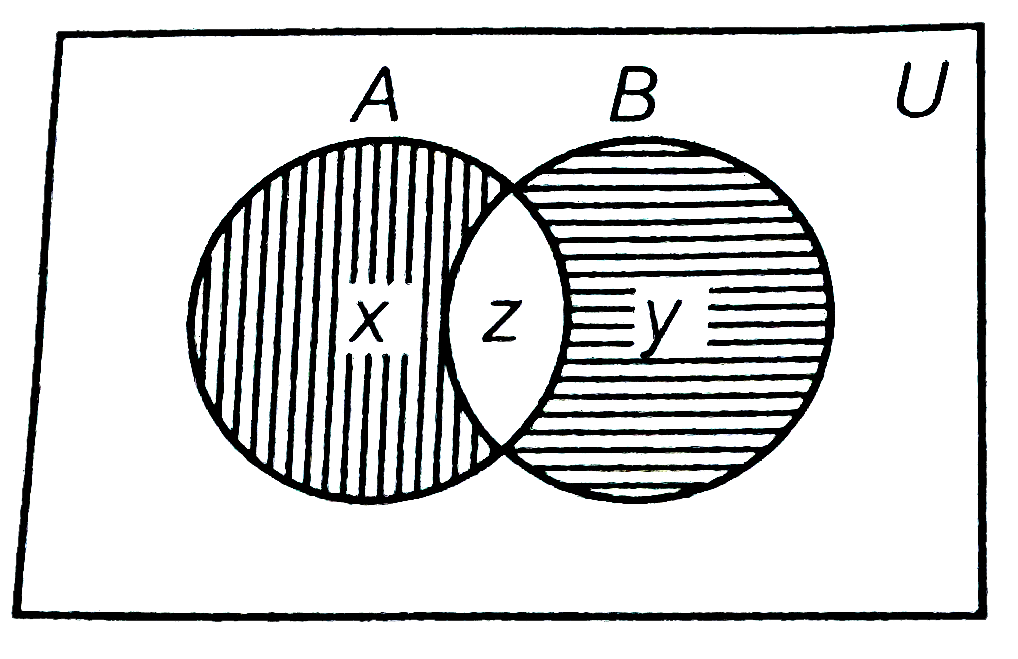If A, B are two sets, prove that A∪B=(A−B)∪(B−A)∪(A∩B).
Hence or otherwise prove that
n(A∪B)=n(A)+n(B)−n(A∩B)
where, n(A) denotes the number of elements in A.
Video Solution
Text Solution
Let x∈A∪B⇒x∈Aorx∈B
iff(x inAandxcancelinB)or(x inBandxcancelinA)
or (x∈Aandx∈B) [from definition of union]
⇔x∈(A−B)orx∈(B−A)orx∈A∩B
⇔x∈(A−B)∪(B−A)∪(A∩B)
∴A∪B⊆(A−B)∪(B−A)∪(A∩B)
and (A−B)∪(B−A)∪(A∩B)⊆A∪B
Hence, A∪B=(A−B)∪(B−A)∪(A∩B)
Let the common elements in A and B are z and only element of A are x (represented by vertical lines in the Venn diagram) and only element of B are y (represented by horizontal lines in the Venn diagram)

∴n(A) = Total elements of A = x + z
n(B) = Total elements of B = y + z
n(A∩B) = Common elements in A and B = z
Now, n(A∪B) = Total elements in complete region of A and B
x + y + z
=(x+z)+(y+z)−z
=n(A)+n(B)−n(A∩B)
Hence, n(A∪B)=n(A)+n(B)−n(A∩B)
|
Topper's Solved these Questions
- SETS, RELATIONS AND FUNCTIONS BOOK - ARIHANT MATHSCHAPTER - SETS, RELATIONS AND FUNCTIONS EXERCISE - Exercise For Session 1
11 Videos
- SETS, RELATIONS AND FUNCTIONS BOOK - ARIHANT MATHSCHAPTER - SETS, RELATIONS AND FUNCTIONS EXERCISE - Exercise For Session 2
10 Videos
- SEQUENCES AND SERIESBOOK - ARIHANT MATHSCHAPTER - SEQUENCES AND SERIESEXERCISE - Exercise (Questions Asked In Previous 13 Years Exam)
38 Videos
- THE STRAIGHT LINESBOOK - ARIHANT MATHSCHAPTER - THE STRAIGHT LINESEXERCISE - Exercise (Questions Asked In Previous 13 Years Exam)
18 Videos
Similar Questions
Knowledge Check
If A and B are two sets, then (A∪B)'∪(A'∩B) is equal to
AA'BACB'DNone of theseIn n(A)=3,n(B)=6andA⊆B then the number of elements in A∪B is equal to
A3B9C6DNone of theseIf A and B are two sets, then (A∪B)'∪(A'∩B) is equal to
AA'BACBDNone of these
Prove that (A∪B)−(A∩B)=(A−B)∪(B−A).
View SolutionFor any two sets A and B , prove that :
(A−B)∪(B−A)=(A∪B)−(A∩B).
View Solution(A−B)∪(B−A)=(A∪B)∩(A'∪B')
View SolutionProve that (A∪B)−(A∩B) is equal to (A−B)∪(B−A).
View SolutionIf A and B are two sets such that n(A∪B)=50,n(A)=28 and n(B)=32, find n(A∩B).
View Solution